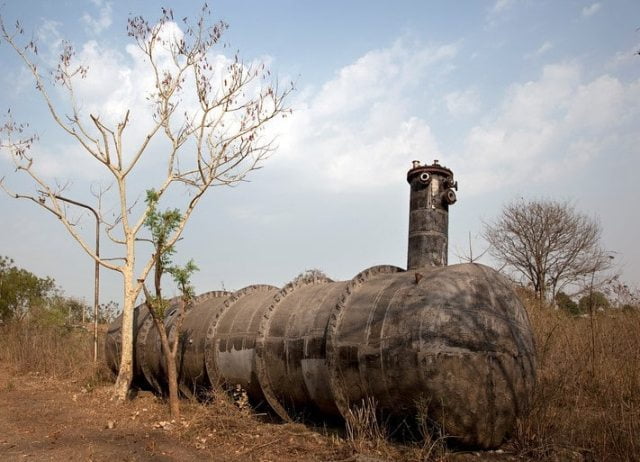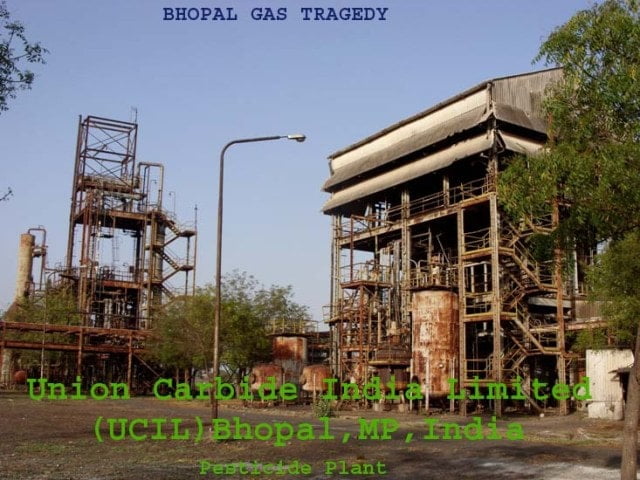The Bhopal gas tragedy also known as the Bhopal gas disaster, was a gas leak incident on the wintry night of 2 December 1984 at the Union Carbide India Limited (UCIL) pesticide plant in Bhopal, Madhya Pradesh, India. It is considered to be the world’s worst industrial disaster.

Table of Contents
MIC Chemical Reactions:


Bhopal gas tragedy case study:
On 2nd December night, the night shift staff of the Union Carbide Factory, Bhopal, took around 11 p.m. There were three double-walled, partly buried S.S. tanks (No. 610, 611and 619) each of 60-tonne capacity and all containing the poisonous gas MIC (Methyl isocyanate) to be used to produce a deadly pesticide Carbaryl.
At 11-30, pm. workers in the plant realized that there was a MIC leak somewhere: their eyes began to tear. A few of them went to the MIC structure and noticed a drop of liquid with yellowish-white gas, about 50 feet off the ground. They told the supervisor who, however, decided to deal with the leak after the tea break which ended at 12:40 night. Meanwhile, the events had moved very fast.
The temperature of tank 610 had reached 25°C at the top of its scale and the pressure was increased twenty times rushing towards 40 psi at which the emergency safety valve was to open. Soon the pressure gauge showed 55 psi, the top of the scale, and the safety valve had opened releasing MIC With a loud hissing sound and tremendous heat. A white cloud drifting over the plant was moving towards the sleeping neighborhood.
The workers tried to operate the safety devices, but nothing seemed to work. The water jet failed to reach the top of the 120-foot stack from which MIC was escaping. The vent gas scrubber to neutralize the escaping gas did not work. The scrubber was under maintenance, the flow meter was not indicating the circulation of caustic soda whose concentration was also not known since October.
The flare tower to burn off the gas could not be ‘used because its piping was corroded and not replaced. The refrigeration system, of 30-tonne capacity, to keep the MIC in a liquid state at 0°C was closed down in June 1984 as an economy drive and the gas was at 15°-20°C Which was unsafe. For approximately two hours, the safety valve remained open releasing over 50,000 pounds of MIC (which might also contain Phosgene, Chloroform, Hydrogen cyanide. Carbon dioxide, etc.) out of 90,000 pounds stored in tank No. 610 at the time of the incident. Sometime between 1-30 to 2-30 am. the safety valve was reseated as the tank pressure went below 40 psi.
As per official records, the Bhopal gas leak killed 3,787 people. The figures were updated by the Madhya Pradesh government later as the immediate official estimate had put the death toll due to a gas leak from the Union Carbide factory at 2,259.
However, activists fighting for justice for Bhopal gas tragedy victims put the figures of death between 8,000 and 10,000. In an affidavit, submitted in 2006, the government said that the Bhopal gas leak caused 5,58,125 injuries that included approximately 3,900 severe and permanently disabling injuries.
Bhopal gas tragedy Causes of the Accident :
(A) Unsafe Conditions of the Bhopal Gas Tragedy
From the published press reports they seem to be:
- The refrigeration system to keep the gas cool was closed for since long.
- The vent gas scrubber was under-designed, not repaired, and not connected.
- The corroded flare tower pipe was not replaced and was not connected.
- The water curtain jests were under-designed to reach the maximum height.
- All three tanks were filled in while one ought to have been kept empty to use as an emergency bypass.
- The computerized pressure/temperature sensing system, a warning device to give the alarm and control the situation at the time of abnormal conditions was not installed.
- The carbon steel valves were used instead of stainless steel and the valves ‘were notorious for leaking.
- The instruments to check the valve leakage were not available.
- The wind direction and velocity indicator were not installed to warn the people about leakage direction and severity.
- The neighboring community was not told of the significance of the danger alarm and the dangers posed by the materials used in the plant.
- Control instruments at the plant were faulty.
- Maintenance and operational practices deteriorated.
- Chemical reactors, piping, and valves were not purged, washed, and aired before maintenance operations.
- The blind disc to disallow the water in the tank through the valve was missing.
- Underqualified workers were running the factory.
- People with chemical engineering backgrounds were replaced by less skilled operators.
- The workers’ strength was reduced from 850 to 642 during the preceding two years and the operator’s duty relieving system was suspended.
- The operating manual was grossly inadequate, not specifying all necessary emergency procedures to control abnormal conditions.
- At the time of the accident, in the MIC control room, there was only one operator who found it virtually impossible to check the 70-odd panels, indicators, and controllers.
- A design modification of the jumper line to interconnect the relief valve vent header and the process vent header was defective, as it allowed the water to go into the MIC tank.
(B) Unsafe Actions of Bhopal gas tragedy :
- The leak was not attended as soon as it was reported. Initial time passed in the tea break.
- The first information about the five-fold pressure rise was dismissed in the belief that the pressure gauge could be faulty.
- A newly recruited supervisor had asked a novice operator to clean a pipe and the blind disc was not inserted while doing so.
- The public siren was put on around 1 am. nearly an hour after the gas leakage and that too for a few minutes.
- The correct antidotes and medical treatments were not suggested to surrounding doctors. On the contrary confusion of MIC or Phosgene or Hydrogen cyanide was confounded.
(C) Unsafe Reactions of Bhopal gas tragedy :
The above unsafe conditions and actions lead to the violent unsafe reaction. Different hypotheses have been expounded by Carbide’s scientists, Indian experts, and Dr. S. Varadrajan, who lead the investigations on behalf of the Government. According to him a small quantity of water reacted with Phosgene in the tank, mixed with MIC as an impurity to make it unstable. The Phosgene water reaction (hydrolysis) produced heat, CO2, and HCI.
The heat and HCI acted as the accelerators of the polymerization, additions, and degradation of MIC leading to a runaway reaction. According to others, the increased temperature of MIC (it vaporizes above 38°C) generated heat, pressure, and side reactions, higher than normal amounts of Chloroform in the stored MIC and an iron catalyst lead to the violent reaction. Because of the colder night of December, the escaped MIC settled down and traveled downward covering the sleeping surroundings with the blanket of death and damages.
What is Methyl isocyanate –
Methyl Isocyanate (MIC) is a chemical that is used in the manufacture of polyurethane foam, pesticides, and plastics. It is handled in liquid form which can be easily burned and explosive. It evaporates quickly in the air and has a strong odor. Its molecular formula is CH3NCO or C2H3NO and its molecular weight is approx. 57.05 g/mol. It is used in the production of pesticides, polyurethane foam, and plastics.
Remedial Measures of the Bhopal Gas Disaster:
All the 25 major causes of this accident stated above in (A) and (B) suggest remedial measures. To avoid repetition, all these contributing causes should be removed first and necessary steps should be taken to run the plant always safe and sound, with all the safety devices properly working. The working conditions must be improved and unsafe actions must be removed by proper policy, training, and education.
The Bhopal incident opened my eyes and gave many lessons to multinationals, developed countries, and developing countries.
Human life must be equally valued everywhere. No double standard for developed and developing countries. ‘Right to Know’ and ‘Obligation to Tell’ concepts are to be covered by the legislation. Training to staff, and workers, emergency procedures, highest standards for plant operation and maintenance and safety equipment, ‘worst case’ study and assessment, etc. were incorporated in 1987.
After the Bhopal gas leak incident :
Bhopal had a population of about 8.5 lakh back in 1984 and more than half of its population was coughing, complaining of itching in the eyes, skin and facing breathing problems. The gas caused internal hemorrhage, pneumonia, and death. The villages and slums in the neighboring areas of the factory were the worst affected.
The alarm system of the Union Carbide did not work for hours. No alarm was raised by the factory managers. Suddenly thousands of people started running to hospitals on the morning of December 3 with their complaints.
Unlike today, Bhopal in 1984 did not have too many hospitals. Two government hospitals could not have accommodated half of the population of the city. People were suffering, finding it difficult to breathe and confused. So were doctors, who did not immediately know the reasons for the sudden illness that afflicted every new rushing patient.
Patients complained of dizziness, breathlessness, skin irritation, and rashes, some others reported sudden blindness. Doctors of Bhopal had never faced a situation like this. They had no experience in dealing with industrial disasters.
Symptoms of methyl isocyanate exposure were not immediately known to them. And, the two hospitals reportedly treated around 50,000 patients in the first two days of the Bhopal gas leak. Officially, the government declared that the gas leakage was contained for eight hours, but the city is still finding it difficult to come out of its grip even 33 years later. So Bhopal incident was the world’s worst industrial mishap.

